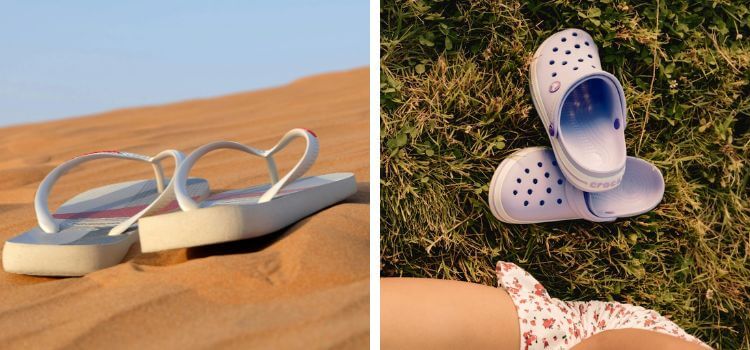As an Amazon Associate I earn from qualifying purchases.

In the ongoing battle of casual footwear, the rivalry between Crocs vs. flip-flops has attracted the attention of fashion fans and comfort-lovers alike. These iconic shoe styles represent contrasting eras and design philosophies, yet they share a common goal: to provide comfort and style for everyday wear.
As consumers navigate the endless aisles of footwear options, understanding the distinctions between flip-flops and Crocs is paramount. Each offers a unique proposition, from their origins to their design features and benefits.
Join us as we explore the nuances of flip-flops and Crocs to help you decide on your next footwear purchase.
Crocs: Origins
Crocs, the iconic footwear brand, originated from a foam clog design intended for boating enthusiasts. In the early 2000s, founders Scott Seamans, Lyndon “Duke” Hanson, and George Boedecker Jr. transformed this concept into a revolutionary shoe. Combining comfort, functionality, and style, Crocs debuted in 2002 and immediately gained popularity globally.
The brand’s signature clog design, featuring ventilation ports and a distinctive silhouette, became its hallmark. With a commitment to innovation, Crocs expanded its product line to include sandals, sneakers, and boots, solidifying its position as a cultural phenomenon and a leader in comfortable footwear.
Flip Flops: Origins
Flip flops, also known as thongs or sandals, trace their origins back to ancient civilizations such as Egypt, Greece, and Rome. Crafted from natural materials like papyrus, palm leaves, and leather, early flip-flops provided basic protection for the soles of the feet in hot climates.
Over time, they developed into more classy designs, with rubber emerging as a popular material in the 20th century. Today, flip-flops remain a staple of casual footwear, embodying a timeless appeal rooted in centuries of tradition and practicality.
Differences Between Crocs vs Flip Flops
In the realm of casual footwear, two iconic brands stand out: flip-flops and Crocs. Both offer unique styles and comfort, but which one reigns supreme? Let’s explore the complexities of both to find out.
Materials: The Foundation of Comfort
Flip Flops
Traditionally made from rubber or foam, flip flops boast simplicity in design and construction. The lightweight materials provide flexibility and breathability, ideal for warm-weather wear. However, the lack of support can lead to discomfort over extended periods.
Crocs
Contrary to popular belief, Crocs aren’t just made of rubber. Their signature Croslite™ material combines resin and closed-cell foam, resulting in a lightweight, durable, and water-resistant shoe. Additionally, Crocs often feature ventilation ports, enhancing breathability and preventing odor build-up.
Design Features: Style vs. Function
Flip Flops
Characterized by a simple thong strap and sole, flip flops prioritize ease of wear and minimalism. While some designs offer embellishments or patterns, they typically maintain a straightforward aesthetic. However, the lack of coverage may leave feet vulnerable to debris or injury.
Crocs
Crocs are renowned for their distinctive clog-like design, featuring a closed-toe box and optional heel strap. This unique silhouette provides ample protection and stability, making them perfect for diverse activities, from informal strolls to outdoor adventures. Moreover, Crocs offers a wide variety of hues and patterns to cater to broad diversity.
Benefits: Comfort and Versatility
Flip Flops
The primary allure of flip-flops lies in their lightweight construction and ease of wear. They are great for lazing by the pool, running short errands, or hitting the beach. Additionally, their tiny size makes them excellent for travel, easily slipping into luggage or beach bags.
Crocs
Crocs excels in both comfort and versatility. The proprietary Croslite™ material molds to the shape of your toes, offering tailored support and cushioning. Whether you’re exploring the excellent outdoors or simply running errands, Crocs offers unparalleled comfort and durability. Furthermore, their water-resistant properties make them suitable for water-based activities, such as fishing or boating.
Durability and Longevity
Flip Flops
While flip flops are affordable and convenient, they may have a shorter lifespan compared to Crocs. Cheaper flip-flops made from low-quality materials may wear out quickly and require frequent replacement, resulting in additional costs over time.
Crocs
Crocs are renowned for their durability and resilience, thanks to the high-quality Croslite material and sturdy construction. With proper care, Crocs can withstand years of wear and keep their shape and comfort. While the initial cost may be higher than flip-flops, the long-term value and durability of Crocs make them a wise investment for many consumers.
Similarities Between Crocs vs Flip Flops
In the ongoing debate between flip flops and Crocs, it’s important to recognize the similarities that make them both popular choices in casual footwear.
Variety of Colors and Styles
Both flip flops and Crocs offer a diverse array of colors and styles to suit every personality and preference. Whether you prefer vibrant hues, subtle tones, or eye-catching patterns, both options provide ample choices to express your unique style.
Lightweight Construction
One of the key similarities between flip flops and Crocs is their lightweight construction. Both are designed to be as light on the feet as they are in the bag, making them ideal companions for long walks, beach outings, or travel adventures. Their lightweight nature offers ease and comfort of wear, even during extended periods.
Secure Straps
Despite their different designs, both flip flops and Crocs feature straps that ensure they stay securely on the feet. Whether it’s a traditional thong strap for flip-flops or an adjustable ankle strap for Crocs, these elements provide stability and prevent slipping or sliding. Additionally, some flip-flop designs feature straps that wrap around the ankle, offering extra security without sacrificing comfort.
In summary, both flip flops and Crocs share similarities in their variety of colors and styles, lightweight construction, and secure straps. These common features contribute to their popularity among casual footwear enthusiasts, offering comfort, style, and practicality for everyday wear.
Unmatched Pair: The Verdict
In casual footwear, the eternal debate between flip-flops and Crocs continues to divide enthusiasts. Flip flops, with their effortless slip-on design and minimalistic appeal, have long been hailed as the go-to choice for casual outings, from beach escapades to mundane errands at the DMV. Their simplicity speaks volumes about their enduring popularity across generations.
However, in the age of innovation, Crocs emerge as a modern upgrade to the traditional flip-flop. Crocs presents a compelling alternative that provides a perfect blend of convenience and comfort. With their extra cushioning and foot-friendly shaping, Crocs outshine flip-flops in terms of longevity and wearability. These versatile shoes boast strategic ventilation holes, allowing for year-round wear without sacrificing breathability.
While some flip-flops may tout features like arch support and durable soles, Crocs take the lead with their enhanced durability and advanced features. Whether braving the summer heat or navigating through cooler seasons, Crocs stand tall as the superior choice for those seeking both style and substance in their footwear.
Amazon and the Amazon logo are trademarks of Amazon.com, Inc, or its affiliates.




Leave a Reply